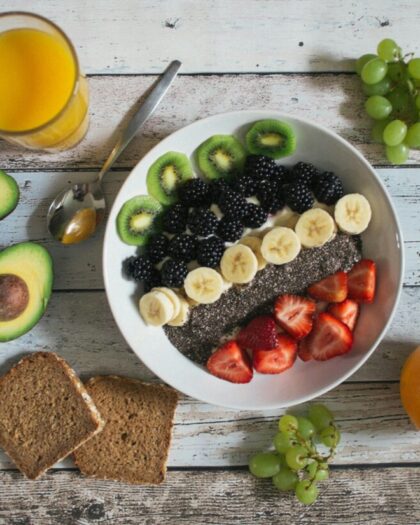
The health of our gut has been an increasing topic of interest in recent years. You may have found yourself wondering, “what is my gut,” and “is my gut healthy?” You may have even found yourself diving into the vast amount of information online into the world of gut health. When it comes to having a healthy gut, it’s almost like we are doing a dance that requires practice and also some patience. For some, gut health may be a new topic you are exploring, for others, you may have already started implementing strategies to help improve your gut health. Below we will discuss a little more of what our gut is and how you can start improving your gut health today.
First, it’s important we start with what we are referring to when we talk about our gut. Technically speaking, our entire digestive tract is about 21 feet long which is about the length of 7 guitars when all lined up. Our digestive tract begins in our mouth, then our esophagus, the stomach, and then continues to our small and large intestines and finally gets excreted as waste. In this post, however, when we reference our ‘gut,’ we are referring more specifically to our small and large intestines.
Our gut is home to “trillions of microorganisms” that all work together to create an environment of balance and harmony, which this is also often referred to as our ‘microbiome’ (Cleveland Clinic, 2023a). When these microorganisms get out of whack and become unbalanced, some of us can have uncomfortable symptoms such as gas, bloating, constipation, or diarrhea. There is also a lot of on-going research about linking the health of our gut in relation to our central nervous system, immune system, as well as our endocrine system with possible effects on our mood, energy and stress levels, ability to fight off infections, and many others (Cleveland Clinic, 2023b).
At this point you may be wondering, “what can I do to improve my gut health?” For each person, this answer is going to vary as each of our gut microbiomes are different and may also depend on the symptoms you are experiencing. However, there are a few nutrients that, for most individuals, can be helpful in improving our gut microbiome, such as prebiotics, probiotics, and fiber to name a few examples. If you’re interested in improving your gut health, a great place to start is by increasing your fiber intake.
Fiber, which is the indigestible part of plant-based food sources, is found primarily in fruits, vegetables, whole grain products, and even nuts and legumes. Fiber has a lot of ‘jobs’ that it does within our digestive tract, such as helping us feel more full and satisfied between meals, helps feed the ‘good’ bacteria in our gut, and can even help lower our blood cholesterol (Duyff 2017). Most of us do not get the recommended amount of fiber per day (25 grams per day for women and 38 grams per day for men, or 14 grams per 1,000 calories consumed) which can have negative effects on the diversity of the organisms and bacteria that live in our gut, and thus possible effects on the overall health of our microbiome. According to researchers Oliver and colleagues, long-term low fiber intake can also be linked to “type 2 diabetes mellitus, heart disease, and colon cancer” (2021).
If you’re interested in getting more fiber in your diet in an effort to improve your gut health, it is recommended to start slowly. Our bodies and digestive tract need time to adjust to the increase in fiber and also requires water intake to be increased at the same time as there is potential for constipation if you increase your dietary fiber intake too quickly without also increasing your water. A few options to start increasing your fiber intake include:
- Switch your refined grains to whole grains. For example, switching white bread for whole wheat bread or switching your morning cereal from Frosted Flakes to Multi-grain Cheerios or oatmeal.
- When having a snack during the day, try adding a fruit or vegetable with it.
- Start by setting a small goal for yourself. If you currently only consistently eat one serving of fruit a day, try increasing this to one fruit and one vegetable for a couple days. When you meet this goal for a few days, try then increasing this to twice a day, and so on.
Gut health is a broad and diverse world that can have profound effects when we are fueling our gut microbiome with the appropriate nutrients and an overall well-balanced diet. If you are interested in learning more about your gut health, talk to one of Total Balance’s Registered Dietitians!
References:
Duyff, Roberta L. Academy of Nutrition and Dietetics Complete Food & Nutrition Guide. Boston New York, Houghton Mifflin Harcourt, 2017.
Gut microbiome. (2023a, Aug 18). In Cleveland Clinic. https://my.clevelandclinic.org/health/body/25201-gut-microbiome
Hills RD Jr, Pontefract BA, Mishcon HR, Black CA, Sutton SC, Theberge CR. Gut Microbiome: Profound Implications for Diet and Disease. Nutrients. 2019 Jul 16;11(7):1613. doi: 10.3390/nu11071613. PMID: 31315227; PMCID: PMC6682904.
Probiotics. (2023c, Oct. 30). In Cleveland Clinic. https://my.clevelandclinic.org/health/treatments/14598-probiotics
The Gut-Brain Connection. (2023b, Sept. 20). In Cleveland Clinic. https://my.clevelandclinic.org/health/body/the-gut-brain-connection
Younkin, Lainey, M.S., RD, LDN. (2023, July 13). Best foods to eat for gut health. EatingWell. https://www.eatingwell.com/article/2059033/best-and-worst-foods-to-eat-for-gut-health/











